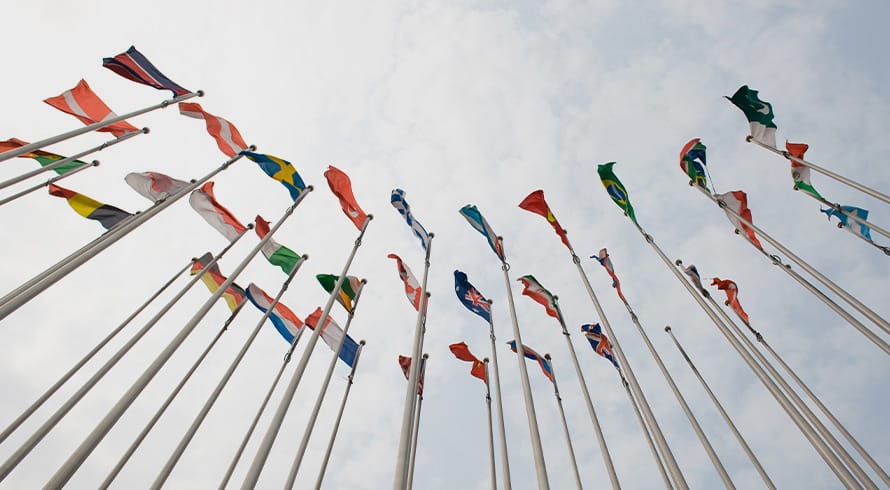Moving towards a green hydrogen energy future
At a glance
- South Africa is shifting towards innovative renewable energy technology and striving to meet its commitments under the Paris Agreement, including reducing greenhouse gas emissions, fostering climate resilience, and achieving carbon neutrality by 2050.
- Green hydrogen, produced through the electrolysis of water using renewable energy sources, is gaining attention in South Africa as a means of reducing emissions. It offers an opportunity for the country to leverage its platinum reserves and develop a domestic and export-oriented hydrogen economy.
- To support the growth of green hydrogen, policymakers need to allocate more resources to renewable energy power generation, address water availability concerns, and establish a supportive policy and regulatory framework for this technology. Continued investment from the government and private sector is crucial for the development of South Africa's green hydrogen sector.
A snapshot of South Africa’s commitments under the Paris Agreement are as follows:
- holding temperature increases to ‘well below 2°C above pre-industrial levels’ and further pursuing efforts to limit temperature increases to 1,5°C above pre-industrial levels;
- increasing South Africa’s ability to adapt to the effects of climate change and to foster climate resilience;
- encouraging low greenhouse gases (GHG) emissions development that does not compromise food production;
- making finance flows consistent with a pathway towards low GHG emissions and climate resilient development;
- reaching a peak in GHG emissions ‘as soon as possible’ while recognising that the timeframes for achieving this will differ between developed and developing countries; and
- achieving carbon neutrality from 2050 onwards.
Green hydrogen produced by renewable energy sources is a technology that is gaining attention in South Africa as a means of reducing GHG emissions.
What is green hydrogen?
The World Economic Forum explains that when hydrogen burns, the only by-product is water, which is why hydrogen has been an alluring zero-carbon energy source for decades. However, the traditional process for producing hydrogen, in which fossil fuels are exposed to steam, is not zero carbon. Hydrogen produced this way is called grey hydrogen. If the CO2 is captured and sequestered (stored so that it is not released into the atmosphere), it is called blue hydrogen. Hydrogen produced from coal is called brown hydrogen.
On the other hand, green hydrogen is produced by the electrolysis of water (using an electric current to break water into its component elements of hydrogen and oxygen, with no other by-products). If the electric current used for the electrolysis is produced by a renewable source (e.g. solar PV or a wind turbine), the clean hydrogen produced is known as green hydrogen. The hydrogen produced can then be used to generate energy by way of hydrogen fuel cells or stored in order to be exported.
The primary production costs of green hydrogen is made up of the cost of:
- the renewable electricity supply;
- electrolysis; and
- water supply.
Where green hydrogen is to be exported, the cost of storage and transportation to markets would also be included.
Existing legal and regulatory framework
The South African National Hydrogen Fuel Cell Technology (HFCT) Research, Development and Innovation strategy, more commonly known as the Hydrogen South Africa (HySA) strategy, was approved by cabinet in 2007 and established in 2008 by the Department of Science and Innovation (DSI). HySA was established to stimulate the innovation of the hydrogen value chain in South Africa with the aim to achieve 25% share of the global hydrogen market and fuel-cell catalysts market by 2020. It is evident that even though the strategy was established 13 years ago, it remains ambitious and was clearly not met by 2020.
Hydrogen South Africa is structured into three centres of competence being:
- HySA Catalysis, which focuses on catalysts and catalytic devices (e.g. platinum group metals based catalysts as components of fuel cells) for fuel cells and hydrogen production;
- HySA Infrastructure, which has its focus on technologies for hydrogen generation / production, storage and distribution; and
- HySA Systems, which focuses on systems integration and technology validation.
The White Paper on Energy Policy published in 1998 remains the existing guideline document for energy policy in South Africa.
The Electricity Regulation Act (ERA) 4 of 2006 and the regulations on new generation capacity published under the ERA requires a national level long-term electricity sector plan known as the Integrated Resource Plan (IRP). Amongst other aspects, the IRP establishes long-term planning scenarios to meet electricity demand requirements whilst considering government policy objectives for a diverse generation mix. In the latest version of the IRP, being the IRP 2019, whilst a significant allocation has been made for renewable energy, there is no explicit allocation for green hydrogen technology.
Enabling environment
On 6 February 2021, the Council for Scientific and Industrial Research (CSIR) released a report on power fuels and green hydrogen (CSIR Report). The CSIR Report finds that as a result of South Africa’s wind and solar resources the country has a competitive advantage to produce and export green hydrogen. South Africa is also in a great position to produce green hydrogen technology due to its vast reserves of platinum group metals (PGMs). South Africa has 75% of the world’s platinum reserves, and is the world’s largest producer of PGMs. PGMs form a critical part of fuel cells and are essential as they are used as part of the electrolysis process when producing green hydrogen.
This view was supported by Engie Impact (Engie) who stated in an announcement on 31 March 2021, that the hydrogen economy presents an opportunity for South Africa to leverage its platinum resources to develop a domestic hydrogen economy valued at $10 billion per year. It is also worth noting that green hydrogen’s export potential for South Africa cannot be understated as it was further highlighted by Engie that the export of green hydrogen has the potential to produce $100 Billion per year. Accordingly, the potential revenue from the export of green hydrogen equates to about 29% of South Africa’s GDP (calculated at 2020 GDP values).
It is clear that as South Africa transitions to a low carbon energy sector, the advantages of green hydrogen technology to meet these goals appear uncontested. However, as mentioned above, in order to qualify as clean technology and thereby green hydrogen, the electricity in the electrolysis process must be derived from renewable energy technology. In the South African context, where utility scale IPP renewable energy projects are required to be dedicated to producing and selling power to Eskom, and are restricted from selling excess power to the national grid or to third parties, there appears to be little opportunity in such projects for green hydrogen production.
In the CSIR Report, the CSIR advocates for dedicated renewable energy infrastructure where all of the energy produced supplies the electrolyser plant exclusively. The key reasons advanced for such a position are as follows:
- minimum dedicated electricity supply is required to meet the recommended annual full load hours (FLH) for electrolysers;
- since electrolysers have high capital costs, high utilisation factors (and therefore high FLH) are required for the production of low-cost green hydrogen; and
- the ease at which such hydrogen may be certifiable as renewable in origin when derived from a dedicated renewable energy power generation facility.
The other critical consideration is water availability. With the known shortages of water in South Africa, the requirements of achieving sustainable water resources for communities and the environment would likely be prioritised over the use of such water for green hydrogen production.
The CSIR Report makes a distinction between hydrogen produced for domestic inland use and hydrogen for export and coastal use. In respect of hydrogen for export and coastal use, it was recommended that the feedwater (water used in the production of hydrogen) should be desalinated seawater, and therefore, export hydrogen should be produced at or near the port of shipment. For the production of hydrogen for inland domestic use, the feedwater should desalinated/treated water from heavily contaminated sources not treatable by municipal wastewater treatment plants (i.e. mine water, acid mine drainage and industrial wastewater).
Conclusion
It is clear that South Africa is well positioned to grow the green hydrogen and fuel cell sector as well as to create the platform for a green hydrogen export economy. In order to produce green hydrogen at scale, it is evident that South African policymakers need to support a far higher allocation of renewable energy power generation development. Continued investment by both government and the private sector will have a significant positive impact on South Africa’s green hydrogen energy future, provided that the water is allocated and used in a responsible manner and the relevant policy and regulatory framework is created to support this technology type.
The information and material published on this website is provided for general purposes only and does not constitute legal advice. We make every effort to ensure that the content is updated regularly and to offer the most current and accurate information. Please consult one of our lawyers on any specific legal problem or matter. We accept no responsibility for any loss or damage, whether direct or consequential, which may arise from reliance on the information contained in these pages. Please refer to our full terms and conditions. Copyright © 2025 Cliffe Dekker Hofmeyr. All rights reserved. For permission to reproduce an article or publication, please contact us cliffedekkerhofmeyr@cdhlegal.com.
Subscribe
We support our clients’ strategic and operational needs by offering innovative, integrated and high quality thought leadership. To stay up to date on the latest legal developments that may potentially impact your business, subscribe to our alerts, seminar and webinar invitations.
Subscribe




